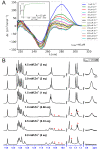The 8-17 DNAzyme can operate in a single active structure regardless of metal ion cofactor
- PMID: 38760331
- PMCID: PMC11101458
- DOI: 10.1038/s41467-024-48638-x
The 8-17 DNAzyme can operate in a single active structure regardless of metal ion cofactor
Abstract
DNAzymes - synthetic enzymes made of DNA - have long attracted attention as RNA-targeting therapeutic agents. Yet, as of now, no DNAzyme-based drug has been approved, partially due to our lacking understanding of their molecular mode of action. In this work we report the solution structure of 8-17 DNAzyme bound to a Zn2+ ion solved through NMR spectroscopy. Surprisingly, it turned out to be very similar to the previously solved Pb2+-bound form (catalytic domain RMSD = 1.28 Å), despite a long-standing literature consensus that Pb2+ recruits a different DNAzyme fold than other metal ion cofactors. Our follow-up NMR investigations in the presence of other ions - Mg2+, Na+, and Pb2+ - suggest that at DNAzyme concentrations used in NMR all these ions induce a similar tertiary fold. Based on these findings, we propose a model for 8-17 DNAzyme interactions with metal ions postulating the existence of only a single catalytically-active structure, yet populated to a different extent depending on the metal ion cofactor. Our results provide structural information on the 8-17 DNAzyme in presence of non-Pb2+ cofactors, including the biologically relevant Mg2+ ion.
© 2024. The Author(s).
Conflict of interest statement
The authors declare no competing interests.
Figures









References
MeSH terms
Substances
LinkOut - more resources
Full Text Sources

